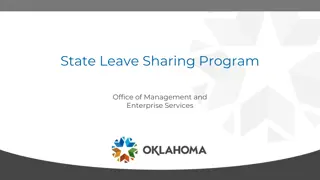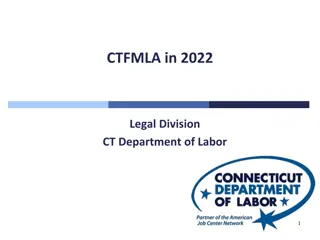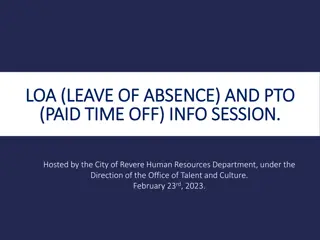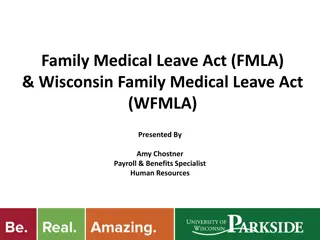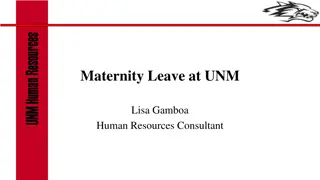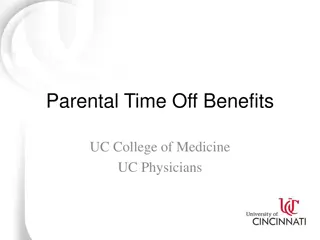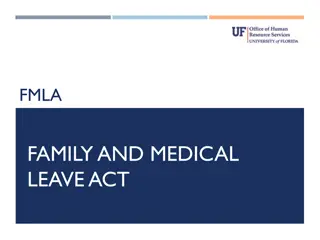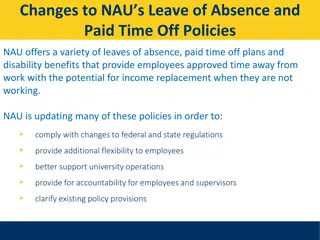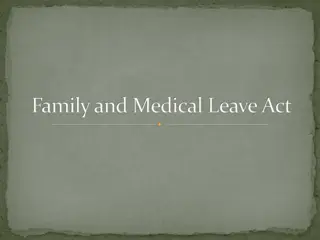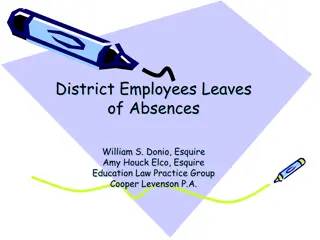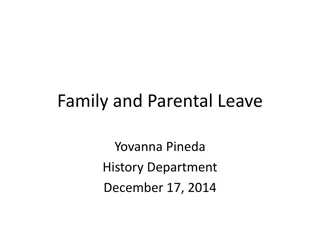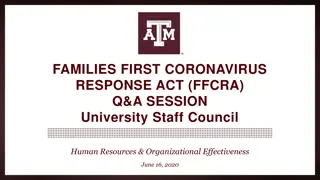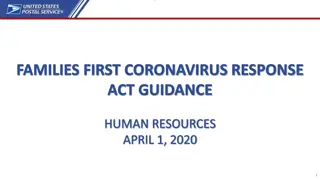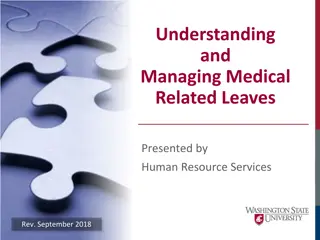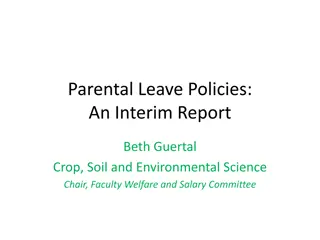Understanding the Family and Medical Leave Act (FMLA)
The Family and Medical Leave Act (FMLA) of 1993 is a federal law designed to help employees balance work and family responsibilities by providing job protection and benefits when they need time off for serious health situations involving themselves or their family members. This act aims to address the needs of working parents, protect employees with serious health conditions, prevent discrimination based on gender, and accommodate military caregiver and exigency leaves. Eligibility criteria, employee/employer rights, and qualifying illnesses or injuries are key aspects covered under FMLA.
Download Presentation

Please find below an Image/Link to download the presentation.
The content on the website is provided AS IS for your information and personal use only. It may not be sold, licensed, or shared on other websites without obtaining consent from the author. Download presentation by click this link. If you encounter any issues during the download, it is possible that the publisher has removed the file from their server.
E N D
Presentation Transcript
Family and Medical Leave Act (FMLA) Southern Illinois University Edwardsville Office of Human Resources Rendleman Hall, Room 3210 April 6, 2017
The Family and Medical Leave Act (FMLA) The Family and Medical Leave Act of 1993 (FMLA) is a federal law designed to help employees preserve their jobs and benefits when they need time off work to deal with serious health situations involving themselves, a spouse, a child, parent, or next-of-kin (in the case of a military caregiver leave). FMLA can help employees balance family needs with work schedules so they may take care of critical life events without losing employment and health insurance coverage. 2
Reasons for the Family and Medical Leave Act The number of single-parent and two-parent households in which the parents work has increased significantly. The development of children and family units is important. Lack of employment policies to accommodate working parents. Inadequate job protection for employees who have serious health conditions. Roles of men and women in our society in which primary responsibility often falls on women to provide care. Employment standards that apply only to one gender may create the potential for an employer to discriminate. Increased need for military caregiver and exigency leaves. 3
Employee/Employer Rights With the appropriate amount of accrued sick/vacation time, FMLA entitles an employee to continue insurance benefits while on leave. If the employee does not have the appropriate amount of accrued sick/vacation time, the employee will be billed by CMS for insurance premiums. Allows the employee the right to return to the same or an equivalent position with equal pay, benefits, and working conditions at the conclusion of the leave. Since an employee s job is protected when they are absent from work on FMLA, no negative employment actions will be taken against them due to the absence. Gives the employer the right to 30 days of advanced notice from the employee where practical. 4
Employee Eligibility To be eligible for FMLA benefits, the employee must: Currently work for a covered employer at a location in the United States or any territory or possession of the U.S. where at least 50 employees are employed within 75 miles. Have worked for the employer for a total of 12 months prior to the leave. Have worked at least 1,250 hours over the previous 12 months prior to the leave. 5
FMLA Qualifying Illness or Injury Employee's own serious health condition that prohibits the employee from performing all or part of the essential functions of his or her position within the meaning of the Americans with Disabilities Act. Birth of a child and care of the child within the 12 months immediately following the birth. Placement of a child in the employee's home for adoption or foster care within 12 months immediately following the placement. Physical or psychological care due to a chronic or serious health condition of the employee's immediate family because of a mental or physical disability as defined by the Americans with Disabilities Act. 6
Serious Health Condition A serious health condition of an employee is defined as: A condition that makes the employee unable to perform the functions of his or her position. The care of an immediate family member who has a serious health condition: An immediate family member is a legally married spouse, parent, son, daughter, or licensed civil union partner. Parent means the biological parent, adoptive parent, or step- parent of an employee. This does not include in-laws. Son or daughter means a biological, adopted, or foster child, stepchild, or a legal ward of the employee. Note: All diagnoses must be supported by a medical certification completed by the physician. 7
Chronic Health Condition An employee claiming a chronic health condition: - Must make at least two in-person visits to a health care provider each year for the same underlying condition. - May have episodic incapacity rather than a continuing period of incapacity. 8
Intermittent and Reduced Schedule Leave Intermittent leave is leave that is taken at various periods of time for a single qualifying reason. Must be medically necessary. Can be planned or unplanned. Foreseeable intermittent leave should be scheduled to avoid disrupting the department s daily operation. FMLA also allows for a temporary, reduced work schedule if necessitated by an FMLA-qualifying condition. This will be coordinated with the department. If the department is unable to accommodate the request, the department will work with Chad Martinez, Director of the Office of Equal Opportunity, Access, and Title IX Coordination, on a reasonable solution. 9
Military Exigency Leave Eligible employees are granted up to 12 weeks of unpaid, job- protected leave during any 12-month period for qualifying exigencies that arise when the employee s spouse, civil union partner, son, daughter, or parent is on covered active duty or has been notified of an impending call or order to covered active duty. The qualifying exigencies include: Short-notice deployment Military events and related activities Child care and school activities Financial and legal arrangements Counseling Rest and recuperation Post-deployment activities Parental care Note: A copy of the military documentation is required in order for the leave to be approved. 10
Military Caregiver Leave Relatives of seriously injured or ill service members are eligible for up to 26 weeks of unpaid FMLA caregiver leave. Eligible relatives include spouses, civil union partners, parents, children, and next of kin. Next of kin includes siblings, grandparents, aunts, uncles, first cousins, and any relative so designated by the service member. Note: A copy of the military documentation is required in order for the leave to be approved. 11
FMLA Leave FMLA runs concurrently with sick leave, vacation, disability, worker s compensation, and other types of leave. The 12-month period for leave entitlement begins the first day the employee is off work due to a qualifying event. Leave entitlement is calculated on a rolling year basis. 12
Work-Related Injury or Illness Worker s Compensation claims must be approved by TRISTAR. If you have questions about Worker s Compensation, please contact Tayanna Crowder in the Benefits office. All Worker s Compensation time must be designated as FMLA and deducted from an employee s FMLA balance. 13
Responsibilities of the Employee Complete the FMLA application and give it to your supervisor for approval. Submit the application to the HR office. Have the doctor complete the medical certification and submit it to the HR office. Provide a return-to-work slip to HR and return to work on that date. If intermittent, notify the department that your time taken off work is for FMLA. 14
Responsibilities of an Employees Supervisor When to advise employees of FMLA rights: Absentee issues due to an illness or a disclosed medical condition If an employee discloses that he/she is suffering from an ongoing medical condition, the supervisor should notify Benefits about the possibility of FMLA. The ongoing medical condition can be for either the employee or an employee s covered family member. Visible, serious health condition 15
Responsibilities of an Employees Supervisor Ensure that Benefits is advised and that an FMLA application is completed when: An employee requests leave. An employee is off work on sick leave for more than 3 consecutive days. An employee requests intermittent leave or a reduced/altered work schedule for any of the reasons covered by FMLA. The application can be provided by either the supervisor or the employee once the supervisor has signed. Review the timesheet of an employee on FMLA leave for accuracy. Submit a Payroll/Personnel Reporting form if needed to place the employee on a medical leave or to report absence without pay. 16
Approved FMLA Medical Leave Once the medical leave has been approved, Benefits will contact the employee and the department. The department must submit to Benefits all intermittent and continuous FMLA leave. Please include the dates the leave was taken and how many hours were used as well as the employee s name and 800#. Send an email to intermittentfmla@siue.edu. All medical documentation must remain in the Benefits office. NO originals or copies of medical documentation should remain in the department. 17
Approving and Tracking FMLA Leave Based on the documentation provided by the employee s medical professional, Benefits will make the final determination if the leave qualifies for FMLA. The department and/or employee will submit intermittent FMLA leave time to Benefits at intermittentfmla@siue.edu. Benefits tracks block FMLA leave to ensure that employees do not max out the time available in one calendar year (450 hours/12 weeks) in accordance with federal law. 18
Supervisor Responsibilities - Return to Work Please keep Benefits informed of the employee s leave status or any changes to that status. Direct employees to Benefits for any updates on their status. Benefits will contact the department to approve any restrictions before an employee can return to work. The employee must provide Benefits with a physician s release before returning to work if the date is different from that on the medical certification. 19
Employee Responsibilities - Return to Work Once an employee is cleared to return to work, the employee must notify Benefits and the department of the return date. The written physician s release to Benefits should be submitted prior to the return to work. Report to work on the return date provided by the physician. 20
Leave Extension If the leave needs to be extended and the return-to-work date changes, medical documentation must be provided prior to the original release date with an explanation and a new expected return date. Failure to report to work on the return date or failure to provide physician s documentation could result in discipline. Ongoing intermittent FMLA must be medically recertified every 6 months if there is still a need for medical leave. Employees/Departments must monitor the end date of an ongoing intermittent FMLA situation. Benefits will not provide a reminder at the end of the intermittent FMLA leave. 21
Scenario 1 Jamie has just learned that she is pregnant with her first child. She has worked for her current company for three years and is full-time. She is excited about starting a family, but she knows that she needs to continue working after the baby is born. She doesn't know what options are available to her or what she needs to do. Is Jamie covered under FMLA? 22
Answer YES! Pregnancy is covered under FMLA, so Jamie is eligible for 12 weeks of leave, and she is entitled to return to her job. She should visit the Benefits website to get information about FMLA. When Jamie is ready to share the news with her department, she should Fill out the FMLA application indicating that she needs time off. Notify her supervisor and have him/her sign her FMLA request. Have her physician complete and sign the appropriate medical certification located on the Benefits website. Forward the completed FMLA application and medical certification to the Benefits department. Jamie may use accrued sick or vacation during her maternity leave. 23
Scenario 2 Sara just learned that her mother had a stroke. She needs to travel out of state to take care of her mother and to make long-term care arrangements, if necessary. Sara has worked for her current employer for fifteen years and is a full-time, Civil Service employee. Is Sara eligible for FMLA? 24
Answer YES! Sara is eligible for up to 12 weeks of FMLA to care for her mother. Using the FMLA application, she needs to request the leave from her supervisor and contact Benefits as soon as possible. She will need to provide medical certification for her mother's health condition within 15 days. If Sara has to take time to move her mother to a care facility, that will also be covered by the FMLA. With the recent change in the sick leave policy, Sara may use either sick or vacation time even though her mother does not live in her household. 25
Scenario 3 Kim has worked for SIUE for 12 months and has always worked 20 hours per week. Based on the length of service and hours worked, Kim is eligible for FMLA leave. True or False? 26
Answer FALSE! SIUE employees must have worked for at least 12 months and a minimum of 1,250 hours during the previous 12 months in order to be considered eligible for FMLA leave. Kim worked 20 hours a week for 52 weeks of employment or 1,040 hours. 27
Scenario 4 George is out for a full week with bronchitis. He went to the doctor and got a prescription for an antibiotic. George has worked for SIUE for five years and is full-time. Is this a serious health condition covered by FMLA? 28
Answer YES! George was treated by a physician only once but was under continuing supervision because he was taking a prescription medication. 29
Scenario 5 Debbie s daughter has food allergies, which are sometimes so serious that Debbie has to stay home with her and that she requires frequent physician appointments. Debbie has worked for eleven years and is full-time. Are these frequent absences covered by FMLA? 30
Answer YES! After requesting time off using the FMLA application and providing the appropriate medical certification required, Debbie learns from Benefits that her daughter's allergies qualify as a serious health condition and that she is entitled to use intermittent FMLA. Benefits will inform Debbie s supervisor when she has been approved for intermittent FMLA leave. Debbie must also inform her supervisor when she is taking leave intermittently for this medical reason only. The department must inform Benefits immediately of any intermittent leave taken. This can be accomplished by emailing intermittentfmla@siue.edu to accurately track the authorized leave. This email should only be used to track intermittent FMLA leave. 31
Scenario 6 John is having cardiac complications. His doctor wants to perform surgery next week. He will need to take two days off for the surgery (prep and surgery) and then three weeks off for recovery. After that, he will have follow-up appointments for the next six months. He has been an employee for two years and is full-time. Will John s leave be covered under FMLA? 32
Answer YES! John s condition would be considered a serious health condition. As long as his leave is tied to either treatment or recovery of his condition, then he would be eligible for up to 12 weeks of leave under FMLA. This example is a combination of block and intermittent FMLA. 33
Scenario 7 Nick has been approved for intermittent FMLA due to debilitating migraines. His department has asked him to bring a medical certification each time he is out with a migraine. He has been a full- time employee for eight and a half years. Is this policy allowable with FMLA regulations? 34
Answer NO! Benefits may request a medical recertification for intermittent FMLA no more than six months from the date the intermittent FMLA was approved. The employee must be given 15 calendar days to produce it. An employer may not request recertification in less than the period specified unless An extension of the leave is requested. Circumstances described by the previous certification have changed. The employer receives information that casts doubt on the reason for the employee s absence. 35
Scenario 8 Sandy dropped a computer monitor on her foot while at work. She has applied for worker s compensation since she broke several toes and is unable to work. She has only been a full-time employee for a year and a half. Is Sandy eligible for FMLA leave? 36
Answer YES! FMLA does not distinguish between work-related and non-work- related injuries. If the employee is eligible for leave under FMLA and the injury is considered a "serious health condition," the worker s compensation leave is treated under FMLA. Any on-the-job injury that requires an employee to take leave for inpatient care or continuing treatment likely will be covered by FMLA. 37
Contact Information For further information or questions about FMLA, please visit: http://www.siue.edu/humanresources/benefits/leaves/fmla/index.sht ml Email: Phone: Fax: benefitshr@siue.edu 618-650-2190 618-650-2646 38




